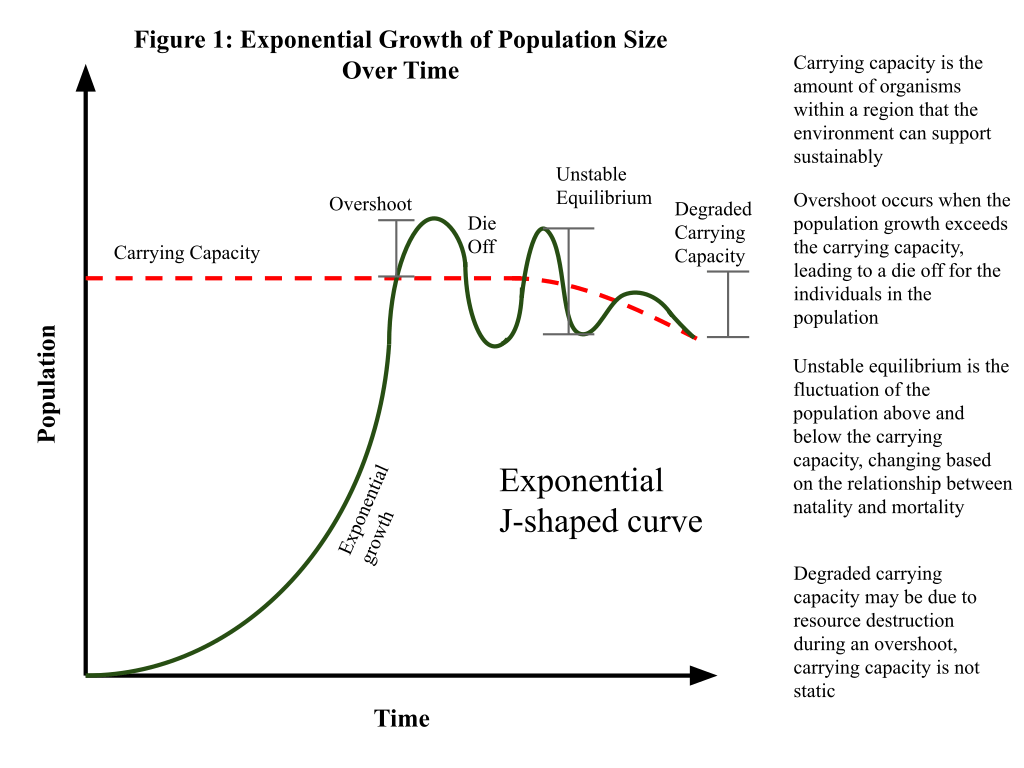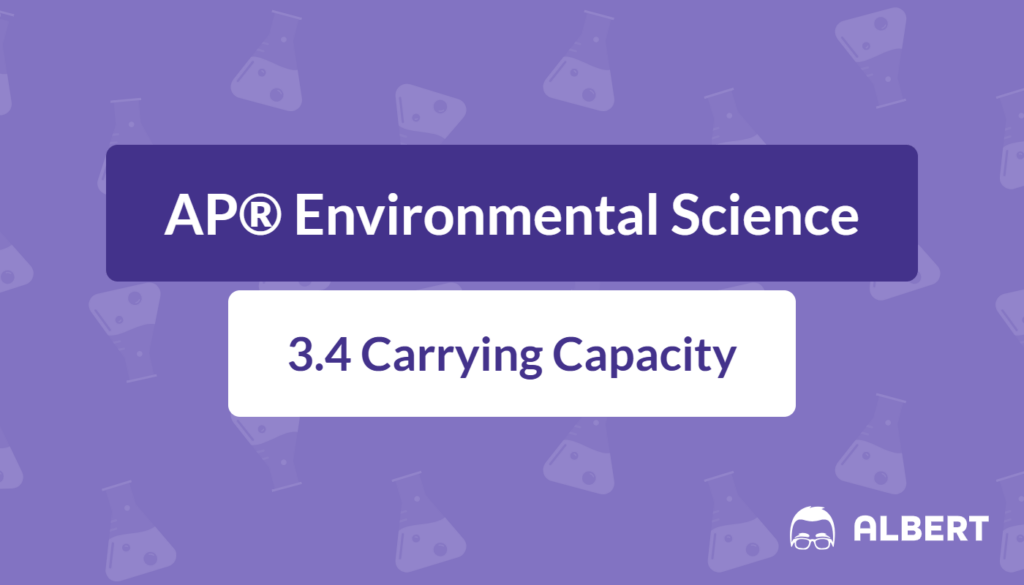What We Review
Introduction
Carrying capacity in ecology influences how populations grow and thrive in an ecosystem. It sets an upper limit on the number of individuals that an environment can support, often denoted as K. In AP® Environmental Science, this concept is essential because it determines the balance between population size and resource availability. Moreover, questions about carrying capacity frequently appear on the exam, testing students’ understanding of how resource limits affect organisms and ecosystems.
The purpose of this article is to introduce the concept of carrying capacity in an easily digestible manner. Additionally, it explains overshoot, dieback, and some practical strategies for managing populations sustainably. By mastering these ideas, students can strengthen their knowledge of key principles in population growth models, resource management, and broader ecological interactions.
What Is Carrying Capacity?
Carrying capacity in ecology refers to the maximum population size of a specific species that a particular environment can sustain indefinitely. It is symbolized by K in population growth models. The value of K depends on resource availability, such as food, water, and shelter, as well as factors like predation and competition. When a population approaches its carrying capacity, growth rates typically slow due to limited resources.
Example: A Pond with 100 Fish
Step-by-step illustration:
- Imagine a small pond that can support 100 fish (so K = 100).
- Initially, there might be 20 fish, and they flourish since resources are abundant.
- As the population grows, competition for food increases.
- Once the number of fish nears 100, resources become scarce, preventing further growth.
This example shows how a population stabilizes around the carrying capacity unless significant changes, such as improved habitat conditions or reduced competition, allow it to increase.
The Concept of Overshoot
Overshoot occurs when a population temporarily surpasses its carrying capacity. Populations often overshoot if they have rapid reproductive rates or if environmental conditions appear more favorable than they actually are. However, exceeding K frequently leads to consequences because available resources might run out.
Example: Rabbit Population Exceeding Food Supply
Step-by-step illustration:
- Consider a garden that can naturally support 50 rabbits.
- Due to a mild winter and fewer natural predators, the rabbit population grows to 70.
- Soon, the rabbits deplete the available vegetation.
- As a result, the population density is too high, and competition becomes severe.
In this scenario, the initial spike in population leads to an overshoot, ultimately setting the stage for resource shortages and potential declines.

Environmental Impacts of Overshoot
When a species overshoots its carrying capacity, several environmental problems often follow. First, resource depletion becomes a pressing concern. If organisms consume resources more quickly than the environment can replenish them, the habitat’s overall health may deteriorate. Second, overshoot can disrupt balance within an ecosystem, reducing biodiversity. Certain species might become overabundant, crowding out or harming other organisms.
Example: Depletion in a Deer Population
Step-by-step illustration:
- A forested area might naturally sustain 200 deer.
- Due to lack of predators and abundant food from nearby farms, deer numbers rise to 300.
- The deer overgraze plants and shrubs, leaving little food for other herbivores.
- This decline in vegetation also destroys nesting sites for certain bird species.
Consequently, overshoot does not only affect the species in question but also poses risks to the entire ecosystem.
The Consequences of Exceeding Carrying Capacity
Exceeding carrying capacity can produce considerable stress on a population. One major consequence is dieback, which refers to a sudden decline in population size as resources can no longer meet demand. Dieback often involves famine, disease, or conflict over remaining resources. This is especially true in ecosystems where organisms lack alternative food sources or where humans have significantly altered habitats.
Example: Dieback in a Fish Population
Step-by-step illustration:
- Fishing activities are allowed on a lake with a carrying capacity of 5,000 fish.
- Overfishing leads to a population reaching 7,000 fish at one point.
- With fewer fish in the lake’s breeding stock, reproduction rates plummet.
- A rapid dieback ensues because there are not enough resources to sustain so many fish.
Dieback highlights how overshoot can trigger sharp population crashes that disrupt a species’ long-term survival.
Managing Carrying Capacity
Sustainable resource management aims to prevent overshoot and maintain population sizes near or below K. This often involves careful monitoring of populations, regulating harvest (like fishing quotas), and preserving habitats. Transitioning to renewable energy sources can also support healthy ecosystems, because it reduces the strain on finite resources and helps preserve habitats for wildlife.
Population management strategies may include:
- Setting catch or hunting limits that align with scientific population estimates.
- Creating protected areas where human activities are restricted.
- Restoring and conserving habitats to enhance carrying capacity.
- Supporting predator-prey relationships to maintain balanced population levels.
Example: Community Efforts to Maintain Fish Stocks
Step-by-step illustration:
- A local fishing community realizes that fish stocks have dropped due to overshoot.
- They set a fishing quota based on scientific data to keep the population near 5,000 (the estimated K).
- They restore wetlands around the lake, expanding spawning areas.
- Continuous monitoring of fish counts ensures that harvest rates remain sustainable.
Through these steps, populations recover and remain stable in the long term, demonstrating that thoughtful management can help ecosystems avoid dieback.
Conclusion
Carrying capacity (K) defines the upper limit that environments can sustain. When populations exceed this limit, overshoot arises, which can have severe implications such as resource depletion, loss of habitat quality, and eventual dieback. Moreover, understanding these concepts can guide responsible management strategies, ensuring that resources remain sufficient for future generations.
Therefore, examining real-world examples—from fish in small ponds to large-scale wildlife management—helps illustrate the ways carrying capacity constrains population growth models. It also reminds everyone that human activities, such as deforestation or overfishing, directly affect the carbon cycle, renewable energy efforts, and the stability of ecosystems. Ultimately, recognizing these relationships supports a deeper appreciation for balanced resource use.
Key Vocabulary
- Carrying Capacity (K): The maximum number of organisms an environment can support indefinitely based on resource availability.
- Overshoot: When a population temporarily exceeds its carrying capacity, often leading to resource depletion and population stress.
- Dieback: A sudden population decline following overshoot, typically due to famine, disease, or competition over scarce resources.
- Resource Depletion: The exhaustion of essential materials or nutrients within an environment, often triggered by overshoot.
- Ecosystem: A community of organisms interacting with each other and their physical environment to form a functional unit.
Sharpen Your Skills for AP® Environmental Science
Are you preparing for the AP® Environmental Science test? We’ve got you covered! Try our review articles designed to help you confidently tackle real-world AP® Environmental Science problems. You’ll find everything you need to succeed, from quick tips to detailed strategies. Start exploring now!
- AP® Environmental Science: 2.7 Review
- AP® Environmental Science: 3.1 Review
- AP® Environmental Science: 3.2 Review
- AP® Environmental Science: 3.3 Review
Need help preparing for your AP® Environmental Science exam?
Albert has hundreds of AP® Environmental Science practice questions, free response, and full-length practice tests to try out.








